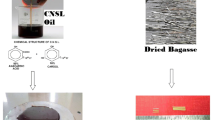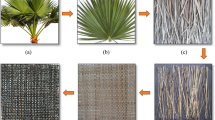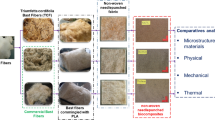Abstract
In recent scenario, biocomposites are considered counterpart to synthetic fiber reinforced polymer composites due to their comparable specific mechanical characteristics, sustainability, low energy consumption during manufacturing, low cost and biodegradable nature. In this investigation, the influence of fiber loading and sodium hydroxide (NaOH) treatment on thermo-mechanical, morphological and water absorption properties of Areca Catechu tree peduncle fibers (ACTPFs) reinforced in Unsaturated Polyester Resin (UPR) matrix biocomposite has been explored. The biocomposites with 40 wt.% of ACTPF exhibited maximum mechanical characteristics with tensile, flexural, hardness and impact properties of 63 MPa, 56 MPa, 68 HRRW and 5.33 J/cm2 respectively. Also, the NaOH treatment of ACTPF reinforcement improved the tensile, flexural, hardness and impact properties of biocomposite specimens by 3.9%, 4%, 4.12% and 4.4% respectively. The scanning electron microscopic (SEM) images, X-ray diffraction (XRD) spectrum and Fourier Transform Infrared (FTIR) spectrum of the biocomposites were witnessed to ensure its suitability in industrial applications. The acceptable hydrophilic nature, less density and thermal stability up to 237 °C of biocomposite specimens achieved through NaOH-treated ACTPF reinforcements suit well for interiors of automobile and aerospace sectors.
Graphical Abstract










Similar content being viewed by others
Data availability
This is an ongoing research work, and hence the data cannot be shared at this moment.
References
Cheng P, Peng Y, Wang K, Le Duigou A, Yao S, Chen C (2023) Quasi-static penetration property of 3D printed woven-like ramie fiber reinforced biocomposites. Compos Struct 303:116313. https://doi.org/10.1016/j.compstruct.2022.116313
Li T, Zhang Y, Jin Y, Bao L, Dong L, Zheng Y, Xia J, Jiang L, Kang Y, Wang J (2023) Thermoplastic and biodegradable sugarcane lignin-based biocomposites prepared via a wholly solvent-free method. J Clean Prod 386:135834. https://doi.org/10.1016/j.jclepro.2022.135834
Giri AK, Mishra PC (2023) Optimization of different process parameters for the removal efficiency of fluoride from aqueous medium by a novel bio-composite using Box-Behnken design. J Environ Chem Eng 11(1):109232. https://doi.org/10.1016/j.jece.2022.109232
Sanjay MR, Madhu P, Mohammad Jawaid P, Senthamaraikannan S, Senthil SP (2018) Characterization and properties of natural fiber polymer composites: a comprehensive review. J Clean Prod 172:566–581. https://doi.org/10.1016/j.jclepro.2017.10.101
Rangappa SM, Siengchin S, Parameswaranpillai J, Jawaid M, Ozbakkaloglu T (2022) Lignocellulosic fiber reinforced composites: progress, performance, properties, applications, and future perspectives. Polym Compos 43(2):645–691. https://doi.org/10.1002/pc.26413
Sanjay MR, Arpitha GR, Senthamaraikannan P, Kathiresan M, Saibalaji MA, Yogesha B (2019) The hybrid effect of Jute/Kenaf/E-glass woven fabric epoxy composites for medium load applications: impact, inter-laminar strength, and failure surface characterization. Journal of Natural Fibers 16(4):600–612. https://doi.org/10.1080/15440478.2018.1431828
Yorseng K, Rangappa SM, Pulikkalparambil H, Siengchin S, Parameswaranpillai J (2020) Accelerated weathering studies of kenaf/sisal fiber fabric reinforced fully biobased hybrid bioepoxy composites for semi-structural applications: morphology, thermo-mechanical, water absorption behavior and surface hydrophobicity. Construct Build Mater 235:117464. https://doi.org/10.1016/j.conbuildmat.2019.117464
Arun Prakash VR, Francis Xavier J, Ramesh G, Maridurai T, Siva Kumar K, Blessing Sam Raj R (2022) Mechanical, thermal and fatigue behaviour of surface-treated novel Caryota urens fibre–reinforced epoxy composite. Biomass Convers Bioref 12:5451–5461. https://doi.org/10.1007/s13399-020-00938-0
Sabarinathan P, Annamalai VE, Rajkumar K, Vishal K, Dhinakaran V (2022) Synthesis and characterization of randomly oriented silane-grafted novel bio-cellulosic fish tail palm fiber–reinforced vinyl ester composite. Biomass Convers Bioref. https://doi.org/10.1007/s13399-022-02459-4
Anand PB, Lakshmikanthan A, Chandrashekarappa MPG, Selvan CP, Pimenov DY, Giasin K (2022) Experimental investigation of effect of fiber length on mechanical, wear, and morphological behavior of silane-treated pineapple leaf fiber reinforced polymer composites. Fibers 10(7):56–69. https://doi.org/10.3390/fib10070056
Tarique J, Sapuan SM, Khalina A, Ilyas RA, Zainudin ES (2022) Thermal, flammability, and antimicrobial properties of arrowroot (Maranta arundinacea) fiber reinforced arrowroot starch biopolymer composites for food packaging applications. Int J Biol Macromol 213:1–10. https://doi.org/10.1016/j.ijbiomac.2022.05.104
Jenish I, Chinnasamy SGV, Basavarajappa S, SuyambulingamIndran D, Divya YL, Sanjay MR, Siengchin S (2022) Tribo-mechanical characterization of carbonized coconut shell micro particle reinforced with Cissus quadrangularis stem fiber/epoxy novel composite for structural application. J Nat Fibers 19(8):2963–2979. https://doi.org/10.1080/15440478.2020.1838988
Suresh Babu J, Murthy VSS, Pradeep Kumar U, Sathiyamoorthy V, Saravanakumar A (2022) Novel Spinifex littoreus fibre and sugarcane biosilica on mechanical, wear, time dependent and water absorption behaviour of epoxy structural composite, Biomass Convers Bioref. https://doi.org/10.1007/s13399-022-02653-4
Heckadka SS, Nayak SY, Raghavendra Kamath C, Adarsh SP, Samant R (2022) Characterization of a novel polyalthia longifolia mid-rib fibers as a potential reinforcement for polymer composites. J Nat Fibers 19(6):2106–2118. https://doi.org/10.1080/15440478.2020.1798847
Ding L, Han X, Cao L, Chen Y, Ling Z, Han J, He S, Jiang S (2022) Characterization of natural fiber from manau rattan (Calamus manan) as a potential reinforcement for polymer-based composites. J Bioresour Bioprod 7(3):190–200. https://doi.org/10.1016/j.jobab.2021.11.002
Lemita N, Deghboudj S, Rokbi M, Rekbi FML, Halimi R (2022) Characterization and analysis of novel natural cellulosic fiber extracted from Strelitzia reginae plant. J Compos Mater 56(1):99–114. https://doi.org/10.1177/00219983211049285
Njoku CE, Omotoyinbo JA, Alaneme KK, Daramola MO (2022) Characterization of Urena lobata fibers after alkaline treatment for use in polymer composites. J Nat Fibers 19(2):485–496. https://doi.org/10.1080/15440478.2020.1745127
Divya D, Jenish I, Raja S (2022) Comprehensive characterization of Furcraea selloa K. Koch peduncle fiber-reinforced polyester composites—effect of fiber length and weight ratio. Adv Mater Sci Eng 2022(Special Issue): Article ID 8099500. https://doi.org/10.1155/2022/8099500
Ramesh M, Tamil Selvan M, Rajeshkumar L, Deepa C, Ahmad A (2022) Influence of Vachellia nilotica Subsp. indica tree trunk bark nano-powder on properties of milkweed plant fiber reinforced epoxy composites. J Nat Fibers 19(6):13776–13789. https://doi.org/10.1080/15440478.2022.2106341
Mohan Prasad M, Sutharsan SM, Ganesan K, Ramesh Babu N, Maridurai T (2022) Role of sugarcane bagasse biogenic silica on cellulosic Opuntia dillenii fibre-reinforced epoxy resin biocomposite: mechanical, thermal and laminar shear strength properties. Biomass Convers Bioref. https://doi.org/10.1007/s13399-021-02154-w
Prabhu L, Krishnaraj V, Sathish S, Gokulkumar S, Sanjay MR, Siengchin S (2020) Mechanical and acoustic properties of alkali-treated Sansevieria ehrenbergii/Camellia sinensis fiber–reinforced hybrid epoxy composites: incorporation of glass fiber hybridization. Appl Compos Mater 27:915–933. https://doi.org/10.1007/s10443-020-09840-4
Rajeshkumar G, Hariharan V, Indran S, Sanjay MR, SuchartSiengchin J, Maran P, Al-Dhabi NA, Karuppiah P (2021) Influence of sodium hydroxide (NaOH) treatment on mechanical properties and morphological behaviour of phoenix sp. fiber/epoxy composites. J Polym Environ 29:765–774. https://doi.org/10.1007/s10924-020-01921-6
Shi Y, Jiang J, Ye H, Sheng Y, Zhou Y, Foong SY, Sonne C, Chong WWF, Lam SS, Xie Y, Li J, Ge S (2023) Transforming municipal cotton waste into a multilayer fibre biocomposite with high strength. Environ Res 218:114967. https://doi.org/10.1016/j.envres.2022.114967
Kumar S, Saha A (2022) Utilization of coconut shell biomass residue to develop sustainable biocomposites and characterize the physical, mechanical, thermal, and water absorption properties. Biomass Convers Bioref. https://doi.org/10.1007/s13399-022-03293-4
Sharifi A, Mousavi SR, Ghanemi R, Mohtaramzadeh Z, Asheghi R, Mohammadi-Roshandeh J, Khonakdar HA, Hemmati F (2023) Extruded biocomposite films based on poly(lactic acid)/chemically-modified agricultural waste: tailoring interface to enhance performance. Int J Biol Macromol 233:123517. https://doi.org/10.1016/j.ijbiomac.2023.123517
Poomathi S, Roji SSS (2022) Experimental investigations on Palmyra sprout fiber and biosilica-toughened epoxy bio composite. Biomass Convers Bioref. https://doi.org/10.1007/s13399-022-02867-6
Karthik K, Prakash JU, Binoj JS, Mansingh BB (2022) Effect of stacking sequence and SiC nanoparticles on properties of carbon/glass/kevlar fiber reinforced hybrid polymer composites. Polym Compos 43(9):6096–6105. https://doi.org/10.1002/pc.26912
Nooun P, Chueangchayaphan N, Ummarat N, Chueangchayaphan W (2023) Fabrication and properties of natural rubber/rice starch/activated carbon biocomposite-based packing foam sheets and their application to shelf life extension of ‘Hom Thong’ banana. Ind Crops Prod 195:116409. https://doi.org/10.1016/j.indcrop.2023.116409
Balaji A, Kannan S, Purushothaman R, Mohanakannan S, Haja Maideen A, Swaminathan J, Karthikeyan B, Premkumar P (2022) Banana fiber and particle-reinforced epoxy biocomposites: mechanical, water absorption, and thermal properties investigation. Biomass Convers Bioref. https://doi.org/10.1007/s13399-022-02829-y
Thooyavan Y, Kumaraswamidhas LA, Edwin Raj R, Binoj JS, BrailsonMansingh B (2022) Effect of combined micro and nano SiC particles addition on mechanical, wear and moisture absorption features of basalt bidirectional mat/vinyl ester composites. Polym Compos 43(5):2574–2583. https://doi.org/10.1002/pc.26557
Khalili H, Bahloul A, Ablouh E-H, Sehaqui H, Kassab Z, Hassani F-Z, El Achaby M (2023) Starch biocomposites based on cellulose microfibers and nanocrystals extracted from alfa fibers (Stipa tenacissima). Int J Biol Macromol 226:345–356. https://doi.org/10.1016/j.ijbiomac.2022.11.313
Alshahrani H, Prakash VRA (2022) Effect of silane-grafted orange peel biochar and areca fibre on mechanical, thermal conductivity and dielectric properties of epoxy resin composites. Biomass Convers Bioref. https://doi.org/10.1007/s13399-022-02801-w
Xu K, Li Q, Xie L, Shi Z, Su G, Harper D, Tang Z, Zhou J, Du G, Wang S (2022) Novel flexible, strong, thermal-stable, and high-barrier switchgrass-based lignin-containing cellulose nanofibrils/chitosan biocomposites for food packaging. Ind Crops Prod 179:114661. https://doi.org/10.1016/j.indcrop.2022.114661
Beims RF, Rizkalla A, Kermanshahi-pour A, Xu CC (2023) Reengineering wood into a high-strength, and lightweight bio-composite material for structural applications. Chem Eng J 454(1):139896. https://doi.org/10.1016/j.cej.2022.139896
Prabhu P, Jayabalakrishnan D, Balaji V, Bhaskar K, Maridurai T, Arun Prakash VR (2022) Mechanical, tribology, dielectric, thermal conductivity, and water absorption behaviour of Caryota urens woven fibre-reinforced coconut husk biochar toughened wood-plastic composite. Biomass Convers Bioref. https://doi.org/10.1007/s13399-021-02177-3
BrailsonMansingh B, Binoj JS, Anbazhagan VN, Hassan SA, Goh KL, Siengchin S, Sanjay MR, Mariatti M, Liu YC (2022) Characterization of Cocos nucifera L peduncle fiber reinforced polymer composites for lightweight sustainable applications. J Appl Polym Sci 139(22):e52245. https://doi.org/10.1002/app.52245
Ruz-Cruz MA, Herrera-Franco PJ, Flores-Johnson EA, Moreno-Chulim MV, Galera-Manzano LM, Valadez-González A (2022) Thermal and mechanical properties of PLA-based multiscale cellulosic biocomposites. J Market Res 18:485–495. https://doi.org/10.1016/j.jmrt.2022.02.072
Gauss C, Pickering KL (2023) A new method for producing polylactic acid biocomposites for 3D printing with improved tensile and thermo-mechanical performance using grafted nanofibrillated cellulose. Addit Manuf 61:103346. https://doi.org/10.1016/j.addma.2022.103346
Raja T, Munuswamy DB, Francis RR, Vaidya G, Sundararaman S, Devarajan Y (2022) Experimental investigations on the effect of palm oil in kenaf fibre–reinforced basalt particulate hybrid biocomposite. Biomass Convers Bioref. https://doi.org/10.1007/s13399-022-02714-8
Miranda-Valdez IY, Sebastian Coffeng Yu, Zhou LV, Xiang Hu, Jannuzzi L, Puisto A, Kostiainen MA, Mäkinen T, Koivisto J, Alava MJ (2023) Foam-formed biocomposites based on cellulose products and lignin. Cellulose 30:2253–2266. https://doi.org/10.1007/s10570-022-05041-3
Alshahrani H, Arun Prakash VR (2022) Mechanical, fatigue and DMA behaviour of high content cellulosic corn husk fibre and orange peel biochar epoxy biocomposite: a greener material for cleaner production. J Clean Prod 374:133931. https://doi.org/10.1016/j.jclepro.2022.133931
Binoj JS, Manikandan N, Mansingh BB, Anbazhagan VN, Bharathiraja G, Siengchin S, Sanjay MR, Indran S (2022) Taguchi’s optimization of areca fruit husk fiber mechanical properties for polymer composite applications. Fibers Polym 23:3207–3213. https://doi.org/10.1007/s12221-022-0365-2
Qin L, Zhang Y, Fan Y, Li L (2023) Cellulose nanofibril reinforced functional chitosan biocomposite films. Polym Test 120:107964. https://doi.org/10.1016/j.polymertesting.2023.107964
Author information
Authors and Affiliations
Contributions
JSB: investigation, writing—original draft. MJ: review and editing. BBM: writing—original draft. AKP: resources and supporting.
Corresponding author
Ethics declarations
Ethics approval and consent to participate
All the authors demonstrate that they have adhered to the accepted ethical standards of a genuine research study. Also, individual consent from all the authors was undertaken to publish the data prior submitting to journal.
Consent for publication
Written formal consent ensures that the publisher has the author’s permission to publish research findings.
Competing interests
The authors declare no competing interests.
Additional information
Publisher's Note
Springer Nature remains neutral with regard to jurisdictional claims in published maps and institutional affiliations.
Highlights
• Influence of fiber loading and sodium hydroxide treated biocomposites is explored here.
• Biocomposites with 40 wt.% fiber loading exhibited maximum mechanical characteristics.
• Scanning electron microscopic (SEM) images revealed failure pattern of biocomposites.
• X-ray diffraction (XRD) analysis exposed the crystalline nature of biocomposites.
• Fourier Transform Infrared (FTIR) analysis revealed the chemical bonds in biocomposites.
Rights and permissions
Springer Nature or its licensor (e.g. a society or other partner) holds exclusive rights to this article under a publishing agreement with the author(s) or other rightsholder(s); author self-archiving of the accepted manuscript version of this article is solely governed by the terms of such publishing agreement and applicable law.
About this article
Cite this article
Binoj, J.S., Jaafar, M., Mansingh, B.B. et al. Comprehensive investigation of Areca catechu tree peduncle biofiber reinforced biocomposites: influence of fiber loading and surface modification. Biomass Conv. Bioref. (2023). https://doi.org/10.1007/s13399-023-04182-0
Received:
Revised:
Accepted:
Published:
DOI: https://doi.org/10.1007/s13399-023-04182-0




